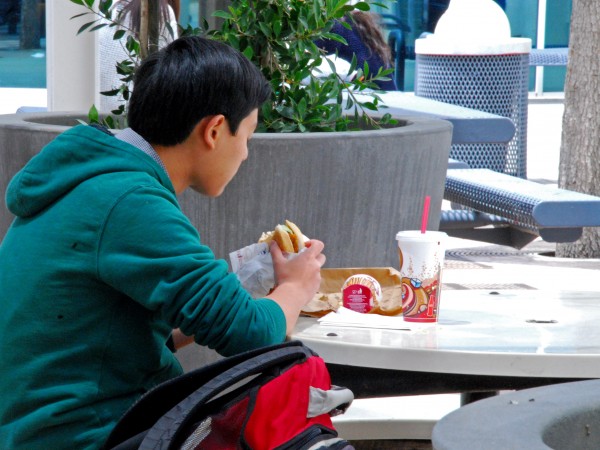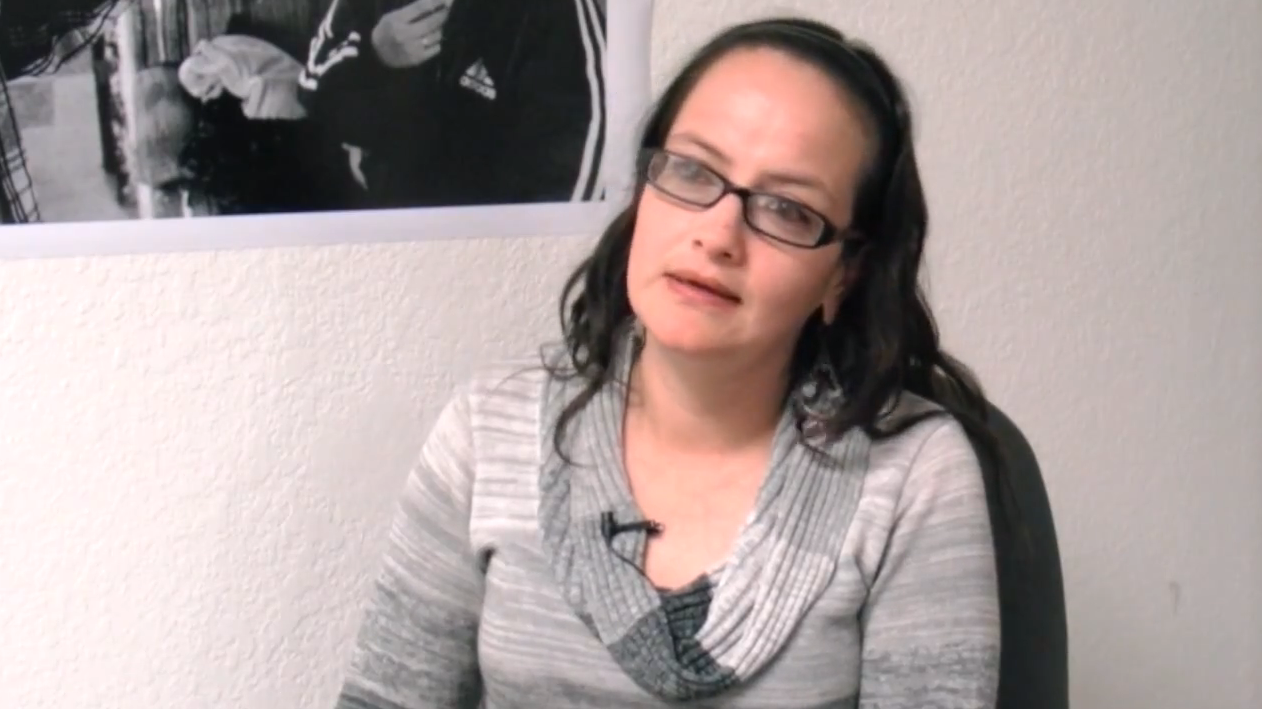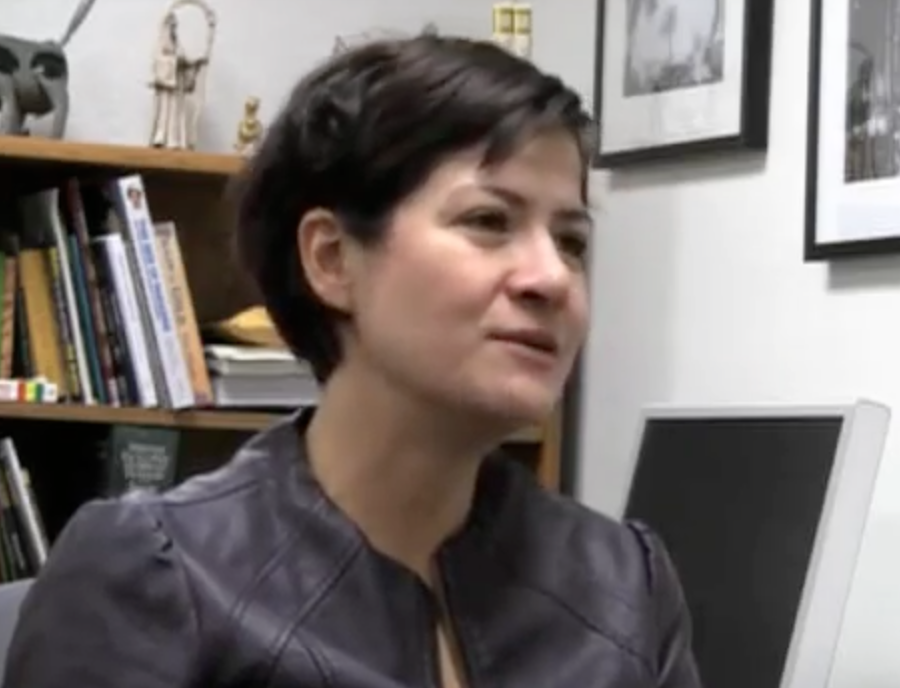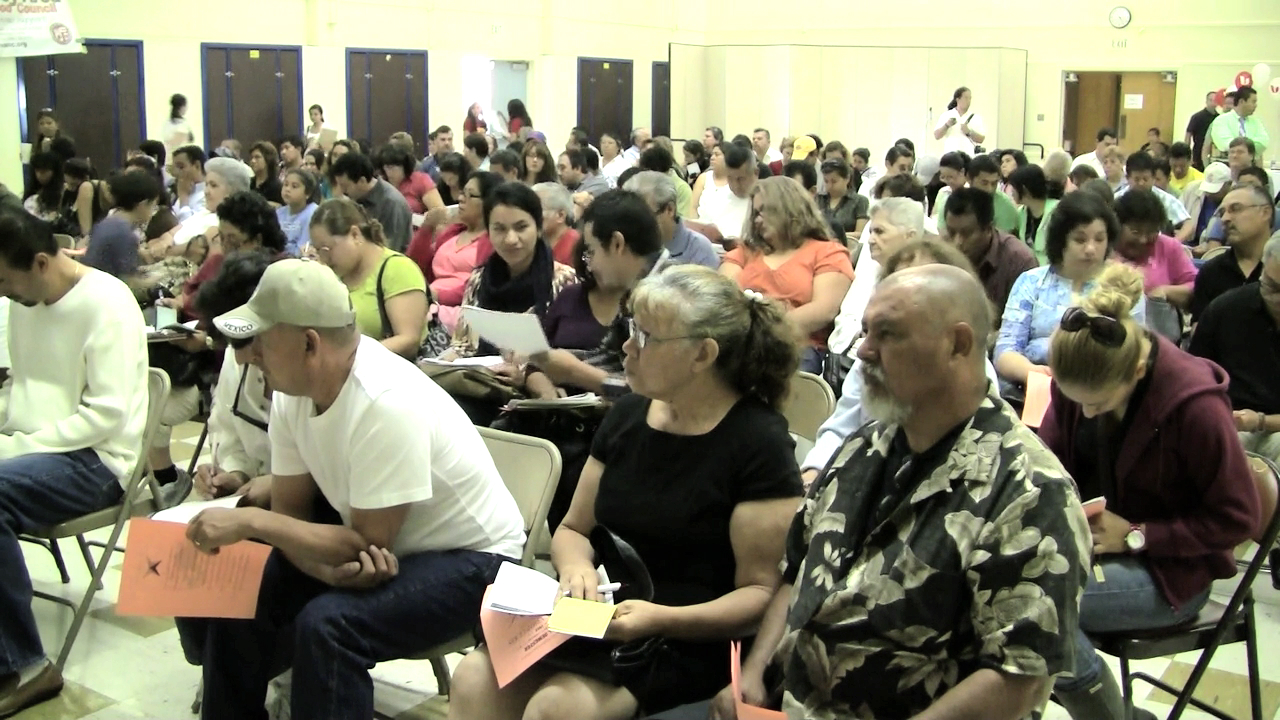Food gardens in schools promote a mentality change when choosing food
By: JESUS ARAUJO, JON GONZALEZ, MARISOL GONZALEZ
EL NUEVO SOL

“Sometimes when the kids get out of school I don’t have enough time to cook something up,” said Gloria Ambris, a Highland Park resident, in Spanish. “With so many choices and dollar menus, it’s more convenient to get fast food.” Photo: Ken Scarboro/El Nuevo Sol.
Versión en español
When driving through the urban, lower class neighborhoods of Los Angeles, there is a visible trend that is made up of graphics, billboard advertisements and food. The metropolis is landscaped with several features, including a fast food restaurant that is in short walking distance from an apartment complex, and billboards that will catch your eyes with phrases like “$5 for 5 hot dogs”, “Me encanta,“ with the letter M displayed across the billboard behind a sweet ice tea, and “$1.29 Fish-O-Fillet Fridays are back”.
The amount of fast food locations has flooded the streets of the city of Angels. It has become more accessible for low-income Latino families in urban cities (Highland Park, Watts, East LA to name a few) to buy fast food at very cheap prices to feed their children, instead of cooking a home cooked meal, with so many fast food restaurants, by the likes of McDonalds, Burger King, Carl’s Jr, and KFC to name a few, that surround their communities.
“Sometimes when the kids get out of school I don’t have enough time to cook something up,” said Gloria Ambris, a Highland Park resident, in Spanish. “With so many choices and dollar menus, it’s more convenient to get fast food.”
Location, transportation, and ability to receive food are vital roles in the equation of healthy food over fast food. Organizations have been helping out in the distribution of healthy fruits and vegetables to youth, not just urban neighborhoods, but rural areas as well.
Early in the career of Anupama Joshi, Farms to Schools program director, she noticed the trends in the food industry and consumerism.
“I noticed a distinct link with not just food, but food that is prescribed for diet, where the food comes from and how it is grown,” she said.
While working at a division of the Urban Environmental Policy Institute at Occidental College in Los Angeles she studied the current food distribution that takes place in Los Angeles. She noted the problems that the city is facing with numerous fast food restaurants and liquor stores that sell food for less than $2.
“I walk seven miles to the supermarket, and I walk seven miles back to my house,” Gloria Ambris, a Highland Park resident, explained in Spanish as her hands clenched the plastic of the grocery bags.
Fast food restaurants are conveniently closer in driving and walking distance, compared to supermarkets. Fast food and liquor stores also accept electronic benefit transfer cards (E.B.T).
The E.B.T card is an identification card for the Cal Fresh food stamp program.
One of the program’s features enables beneficiaries to be used in fast food restaurants and liquor stores.
Certain farmers’ markets also offer their products to E.B.T. card users.
“Farmers’ markets flourish in many locations in Los Angeles and the E.B.T cards are also accepted at certain markets,” Margarita Steven, Pasadena resident, said. “Education to understand the E.B.T card, and how to sign up for E.B.T card are available to the public. “
However, signage in bold letters, visible from two blocks away, remind residents who, walk nearby, opportunities like “E.B.T card accepted” next to a “5 dollar foot long” advertisement at Subway.
According to Rebecca Clair Quinn, an undergraduate student at South Methodist University, a food desert is defined as any area where healthy, affordable food is difficult to obtain and at the same time, consumers have no adequate means of transportation to arrive at the location.
However, Joshi says the definition of food desert doesn’t apply to Los Angeles.
“’Food desert’ is not appropriate term for Los Angeles,” the expert said. “Food deserts are natural phenomenon’s, it is actually a man made condition in Los Angeles.”
The distance is not the problem for supermarkets. On the other hand, the type of healthier food such as fruits and vegetable are higher priced and not organic.
Stevens narrates that being a coupons shopper has its woes.
“You look at the coupons and you see sweets, candies, and soda that are bargains,” the experienced shopper said.
Public transportation seems to trouble some consumers as well.
“Public transportation in Los Angeles is a disaster.” Joshi said. “Even though there is not much public transportation, buses are able to pick up people in low-income areas and take people to farmers’ market.”
With farmers’ markets becoming to appear now, it gives an alternative way to get food, instead of hitching a ride on the bus to a fast food place for a triple stack for $2.99.
An alternative that is taking place not just in Los Angeles but also, in 50 states, is Farms to Schools.
As co-director of the food justice organization, Joshi helps local farmers to cater their produce and reach the elementary, middle school and high school students in the cafeteria.
One of the set backs was that many school officials believed that it was illegal to buy from local farmers or produce from school gardens.
“The Federal government has embraced farms for schools. The district attorney approves and encourages this action in schools.” Joshi said.
Joshi understands the situation at hand with the rise of obesity in the United States, yet has hope for the future of the nation that sit in elementary classrooms.
“Obesity is a long situation,” she said. “Students are now more aware of nutrients and health. … Kids now are having no problem saying no to the $5 box at Taco Bell.”
Even with an additional serving of fruits and vegetables to help the kids reach their five serving of foods a day, the idea of slowing down and eventually stopping obesity is a matter of time.
“BMI and obesity takes five to ten years to make a full diagnostic. It is hard because kids move around.” Joshi explains.
Tish Reed, a fifth grade teacher, is evolved with Growing Great is trying to show the schoolchildren that it is possible to consume the food that they grow.
“You would think that a fifth grader would have gone to plant vegetables before.” Reed explained while her students got dirty with the help of shovels and fresh dirt. “Many kids live in apartments and do not have the sufficient space to grow vegetables.”
Nonetheless, the situation between food choices and low-income communities seems to transforming.
“Students are going to their houses and telling their parents about the food, which causes the parent to start buying healthier food for the children…. What is happening more and more is the youth (students) asking for a change,” Joshi spoke with enthusiasm.
Tags: Desiertos alimentarios Farms to Schools food desert food justice Jesús Araujo Jon González justica alimentria Marisol González













